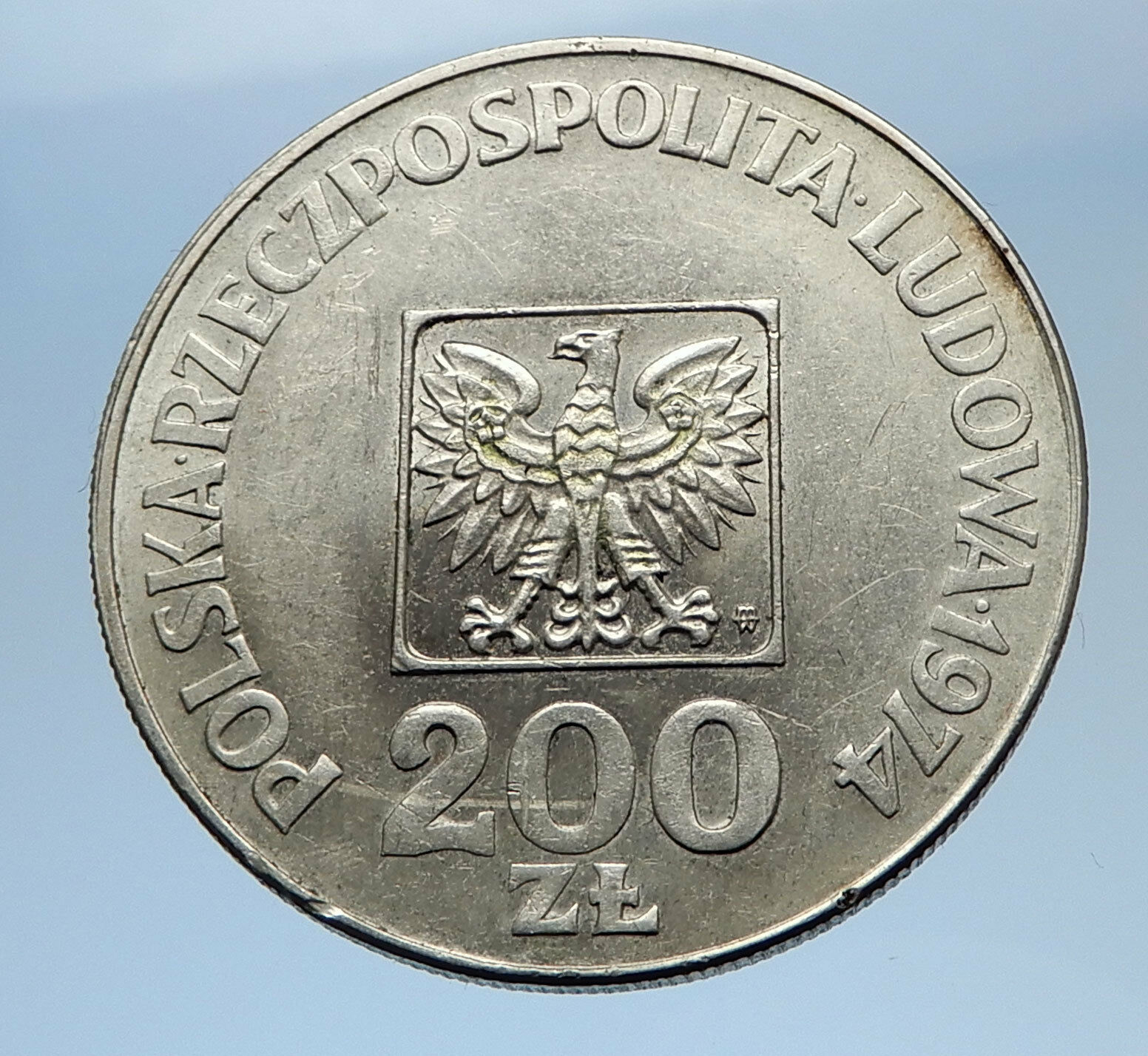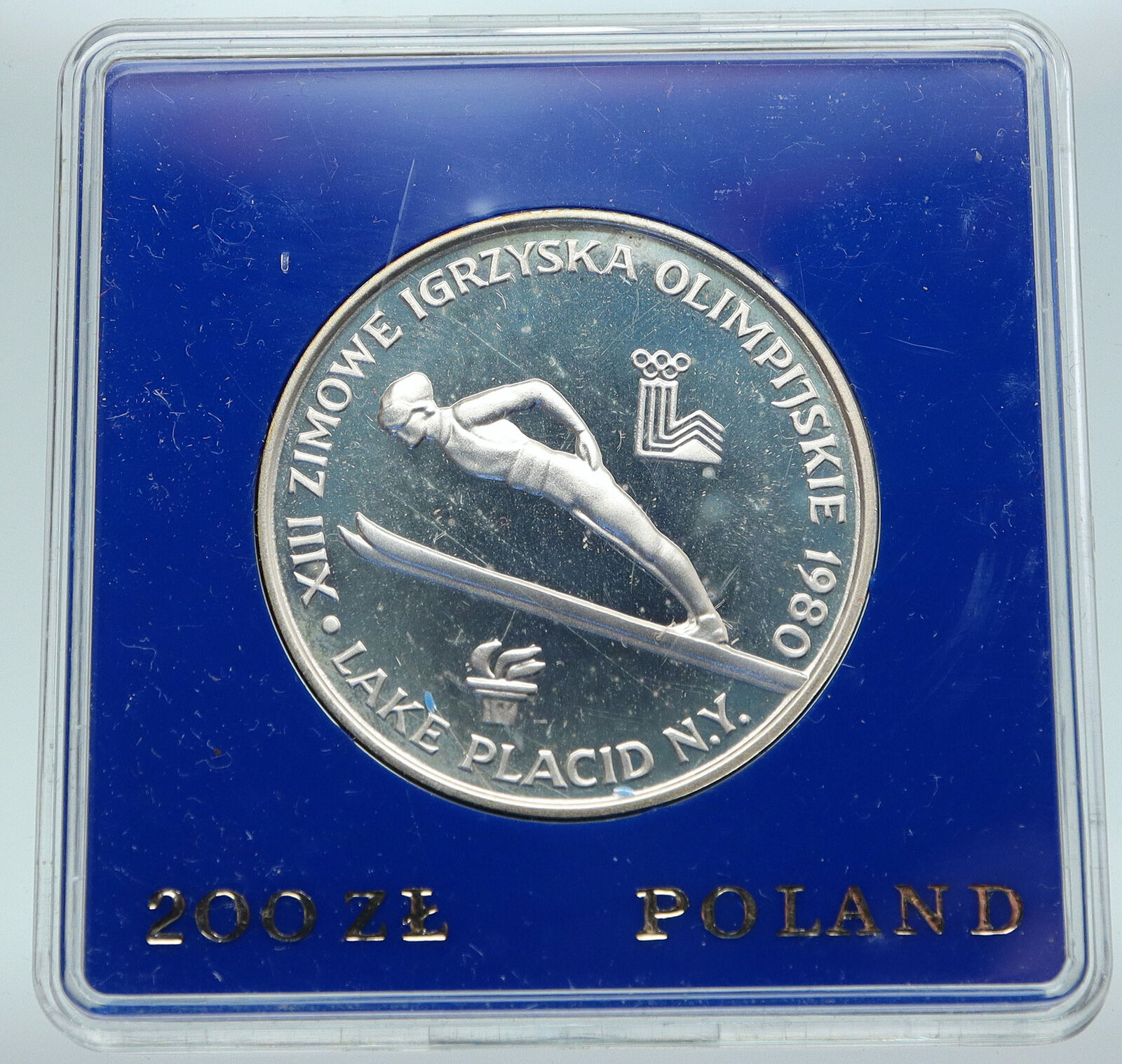|
Poland – Henryk Wieniawski Commemorative issue
1979 Proof Silver 100 Zlotych 32mm (16.76 grams) 0.625 Silver (0.3316 oz. ASW)
Reference: Y# 98 | Mintage; 30,000
POLSKA RZECZPOSPOLITA LUDOWA 19 79 mw ZŁ 100 ZŁ, eagle of Poland.
HENRYK WIENIAWSKI 1835-1880, Bust of Henryk Wieniawski 3/4 left.
You are bidding on the exact item pictured, provided with a Certificate of Authenticity and Lifetime Guarantee of Authenticity.
.jpg/220px-Henryk_Wieniawski_three_quarters_length_(cropped).jpg) Henryk Wieniawski ([vʲɛˈɲafskʲi]; 10 July 1835 – 31 March 1880) was a Polish violinist and composer. Henryk Wieniawski ([vʲɛˈɲafskʲi]; 10 July 1835 – 31 March 1880) was a Polish violinist and composer.
Henryk Wieniawski was born in Lublin, Congress Poland. His father, Tobiasz Pietruszka (Wolf Helman), was the son of a Jewish barber named Herschel Meyer Helman, from the Jewish Lublin neighbourhood of Wieniawa, when barbers were also practising dentists, healers, and bloodletters. Wolf Helman, also known as Tobiasz Pietruszka, changed his name to Tadeusz Wieniawski, taking on the name of his neighbourhood to blend into his Polish environment better. Prior to obtaining his medical degree, he had converted to Catholicism. He married Regina Wolff, the daughter of a noted Jewish physician from Warsaw, and out of this marriage Henryk was born. His talent for playing the violin was recognised early, and in 1843 he was accepted by the Paris Conservatoire, where special exceptions were made to admit him, as he wasn’t French and was only nine years old. After graduation, Henryk toured extensively and gave many recitals, where he was often accompanied by his brother Józef on piano. In 1847, he published his first opus, a Grand Caprice Fantastique, the start of a catalogue of 24 opus numbers.
When his engagement to Isabella Hampton was opposed by her parents, Wieniawski wrote Légende, Op. 17; this work helped her parents change their mind, and the couple married in 1860.
At the invitation of Anton Rubinstein, Wieniawski moved to St. Petersburg, where he lived from 1860 to 1872, taught many violin students, and led the Russian Musical Society’s orchestra and string quartet. From 1872 to 1874, Wieniawski toured the United States with Rubinstein. Wieniawski replaced Henri Vieuxtemps as violin professor at the Conservatoire Royal de Bruxelles in 1875.
During his residence in Brussels, Wieniawski’s health declined, and he often had to stop in the middle of his concerts. He started a tour of Russia in 1879 but was unable to complete it, and was taken to a hospital in Odessa after a concert. On 14 February 1880, Pyotr Ilyich Tchaikovsky’s patroness Nadezhda von Meck took him into her home and provided him with medical attention.[1][2] His friends also arranged a benefit concert to help provide for his family. He died in Moscow a few weeks later from a heart attack and was interred in the Powązki Cemetery in Warsaw.
His daughter Régine Wieniawski, born in Brussels the year before his death, also became a composer. She published her early works as “Irène Wieniawska,” but after marrying Sir Aubrey Dean Paul and becoming a British subject, she used the pseudonym “Poldowski.”[3] Another daughter, Henriette, would go on to marry Joseph Holland Loring in 1904, who was among the victims of the Titanic disaster.
Wieniawski was a player in the Beethoven Quartet Society in London, where he also performed on viola.
Works
Henryk Wieniawski was considered a violinist of great ability and wrote some very important works in the violin repertoire, including two technically demanding violin concertos, the second of which (in D minor, 1862) is more often performed than the first (in F-sharp minor, 1853). His L’École moderne: 10 Études-caprices is a very well known work for aspiring violinists. His Scherzo-Tarantelle, Op.16 and Légende, Op.17 are also frequently performed works. He also wrote several mazurkas for solo violin and piano accompaniment (including the popular Obertass in G major), using techniques such as left-hand pizzicato, harmonics, large leaps, and many double stops.
Legacy
Wieniawski was given a number of posthumous honours. His portrait appeared on a postage stamp of Poland in 1952 and again in 1957. A 100 złoty coin was issued in 1979 bearing his image.
What is commonly called the “Russian bow grip” is sometimes called the “Wieniawski bow grip”, as Wieniawski taught his students his own kind of very rigid bowing technique (like the Russian grip) that allowed him to play what he called a “devil’s staccato” with ease. This “devil’s staccato” was used to discipline students’ technique.[clarification needed]
The first violin competition named after Wieniawski took place in Warsaw in 1935. Ginette Neveu took first prize, David Oistrakh second, and Henri Temianka third. The International Henryk Wieniawski Violin Competition has been held every five years since 1952.

 Poland, officially the Republic of Poland, is a country in Central Europe, bordered by Germany to the west; the Czech Republic and Slovakia to the south; Ukraine and Belarus to the east; and the Baltic Sea, Kaliningrad Oblast (a Russian exclave) and Lithuania to the north. The total area of Poland is 312,679 square kilometres (120,726 sq mi), making it the 69th largest country in the world and the 9th largest in Europe. With a population of over 38.5 million people, Poland is the 34th most populous country in the world, the 8th most populous country in Europe and the sixth most populous member of the European Union, as well as the most populous post-communist member of the European Union. Poland is a unitary state divided into 16 administrative subdivisions. Poland, officially the Republic of Poland, is a country in Central Europe, bordered by Germany to the west; the Czech Republic and Slovakia to the south; Ukraine and Belarus to the east; and the Baltic Sea, Kaliningrad Oblast (a Russian exclave) and Lithuania to the north. The total area of Poland is 312,679 square kilometres (120,726 sq mi), making it the 69th largest country in the world and the 9th largest in Europe. With a population of over 38.5 million people, Poland is the 34th most populous country in the world, the 8th most populous country in Europe and the sixth most populous member of the European Union, as well as the most populous post-communist member of the European Union. Poland is a unitary state divided into 16 administrative subdivisions.
The establishment of a Polish state can be traced back to 966, when Mieszko I, ruler of a territory roughly coextensive with that of present-day Poland, converted to Christianity. The Kingdom of Poland was founded in 1025, and in 1569 it cemented a longstanding political association with the Grand Duchy of Lithuania by signing the Union of Lublin. This union formed the Polish-Lithuanian Commonwealth, one of the largest and most populous countries of 16th and 17th-century Europe. The Commonwealth ceased to exist in the years 1772-1795, when its territory was partitioned among Prussia, the Russian Empire, and Austria. Poland regained its independence (as the Second Polish Republic) at the end of World War I, in 1918.
In September 1939, World War II started with the invasions of Poland by Nazi Germany and the Soviet Union (as part of the Molotov-Ribbentrop Pact). More than six million Polish citizens died in the war. In 1944, a Soviet-backed Polish Committee of National Liberation was formed which, after a falsified referendum in 1947 took control of the country and Poland became a satellite state of the Soviet Union, as People’s Republic of Poland. During the Revolutions of 1989 Poland’s Communist government was overthrown and Poland adopted a new constitution establishing itself as a democracy.
 Despite the large number of casualties and destruction the country experienced during World War II, Poland managed to preserve much of its cultural wealth. There are 14 heritage sites inscribed on the UNESCO World Heritage and 54 Historical Monuments and many objects of cultural heritage in Poland. Despite the large number of casualties and destruction the country experienced during World War II, Poland managed to preserve much of its cultural wealth. There are 14 heritage sites inscribed on the UNESCO World Heritage and 54 Historical Monuments and many objects of cultural heritage in Poland.
Since the beginning of the transition to a primarily market-based economy that took place in the early 1990s, Poland has achieved a “very high” ranking on the Human Development Index, as well as gradually improving economic freedom. Poland is a democratic country with an advanced high-income economy, a high quality of life and a very high standard of living. Moreover, the country is visited by nearly 16 million tourists every year (2013), which makes it one of the most visited countries in the world. Poland is the sixth largest economy in the European Union and among the fastest rising economic states in the world. The country is the sole member nation of the European Union to have escaped a decline in GDP and in recent years was able to “create probably the most varied GDP growth in its history” according to OANDA, a Canadian-based foreign exchange company. Furthermore, according to the Global Peace Index for 2014, Poland is one of the safest countries in the world to live in.
|




.jpg/220px-Henryk_Wieniawski_three_quarters_length_(cropped).jpg) Henryk Wieniawski ([vʲɛˈɲafskʲi]; 10 July 1835 – 31 March 1880) was a Polish violinist and composer.
Henryk Wieniawski ([vʲɛˈɲafskʲi]; 10 July 1835 – 31 March 1880) was a Polish violinist and composer. 
 Poland, officially the Republic of Poland, is a country in Central Europe, bordered by Germany to the west; the Czech Republic and Slovakia to the south; Ukraine and Belarus to the east; and the Baltic Sea, Kaliningrad Oblast (a Russian exclave) and Lithuania to the north. The total area of Poland is 312,679 square kilometres (120,726 sq mi), making it the 69th largest country in the world and the 9th largest in Europe. With a population of over 38.5 million people, Poland is the 34th most populous country in the world, the 8th most populous country in Europe and the sixth most populous member of the European Union, as well as the most populous post-communist member of the European Union. Poland is a unitary state divided into 16 administrative subdivisions.
Poland, officially the Republic of Poland, is a country in Central Europe, bordered by Germany to the west; the Czech Republic and Slovakia to the south; Ukraine and Belarus to the east; and the Baltic Sea, Kaliningrad Oblast (a Russian exclave) and Lithuania to the north. The total area of Poland is 312,679 square kilometres (120,726 sq mi), making it the 69th largest country in the world and the 9th largest in Europe. With a population of over 38.5 million people, Poland is the 34th most populous country in the world, the 8th most populous country in Europe and the sixth most populous member of the European Union, as well as the most populous post-communist member of the European Union. Poland is a unitary state divided into 16 administrative subdivisions. Despite the large number of casualties and destruction the country experienced during World War II, Poland managed to preserve much of its cultural wealth. There are 14 heritage sites inscribed on the UNESCO World Heritage and 54 Historical Monuments and many objects of cultural heritage in Poland.
Despite the large number of casualties and destruction the country experienced during World War II, Poland managed to preserve much of its cultural wealth. There are 14 heritage sites inscribed on the UNESCO World Heritage and 54 Historical Monuments and many objects of cultural heritage in Poland.




